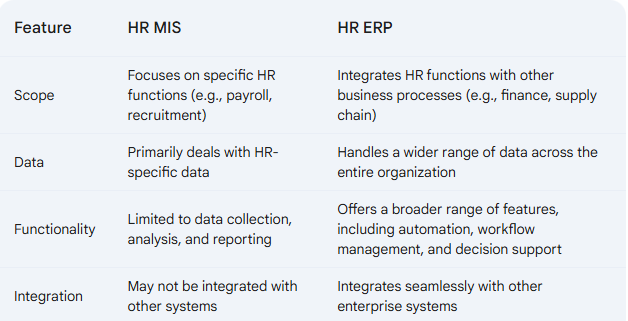HR ERP (Human Resource Enterprise Resource Planning)
HR ERP is an integrated software solution that streamlines and automates human resource management processes across an organization. It consolidates various HR functions, such as recruitment, payroll, performance management, employee onboarding, and compliance, into a single platform. HR ERP systems are designed to improve efficiency, enhance data accuracy, and provide comprehensive analytics and reporting capabilities, often integrating with other business systems like finance and supply chain management.
HR MIS (Human Resource Management Information System)
HR MIS is a system specifically designed to manage and process employee data and HR-related information within an organization. It focuses on storing, retrieving, and processing employee information, such as personal details, attendance, performance records, and training history. HR MIS primarily serves as a database for HR professionals to manage human resources effectively and generate reports for decision-making, but it may not offer the extensive functionality or integration capabilities of an HR ERP system.
Here’s a breakdown of the capabilities and limitations of HR MIS in the context of HR automation:
Capabilities of HR MIS
Data Management:
HR MIS excels at collecting, storing, and managing employee data, including personal information, attendance, performance evaluations, and training records.
Reporting and Analytics:
Provides basic reporting capabilities to help HR professionals analyze workforce metrics, track employee performance, and generate compliance reports.
Process Automation:
Automates routine HR tasks such as employee onboarding, leave management, and payroll processing to some extent, which can improve efficiency.
Compliance Tracking:
Helps organizations track compliance with labor laws and regulations by maintaining records and generating reports.

Limitations of HR MIS
Scope of Automation:
While HR MIS can automate certain HR processes, it may not cover all areas of HR management comprehensively. Complex processes such as talent management, performance management, and succession planning may require additional tools.
Integration Capabilities:
HR MIS systems may have limited integration with other business systems (e.g., ERP, CRM), which can hinder seamless data flow and collaboration across departments.
Customization and Flexibility:
Some HR MIS solutions may lack the customization options needed to tailor the system to specific organizational processes and workflows.
User Experience:
Depending on the system, user interfaces can vary in complexity, which may affect user adoption and overall satisfaction.
Advanced Features:
HR MIS may not offer advanced features like predictive analytics, artificial intelligence, or extensive talent management capabilities that are often found in more comprehensive HR solutions (such as HR ERP systems).
Conclusion
HR MIS can be an effective solution for automating many HR tasks, especially for smaller organizations or those with less complex HR needs. However, for larger organizations or those seeking a comprehensive and integrated approach to HR management, a more robust solution, such as an HR ERP (Enterprise Resource Planning) system, may be necessary. HR ERP systems typically provide broader functionality, better integration, and advanced features that support a more holistic approach to HR automation and management.
Ultimately, the choice between HR MIS and HR ERP solutions depends on the specific requirements, size, and goals of the organization.